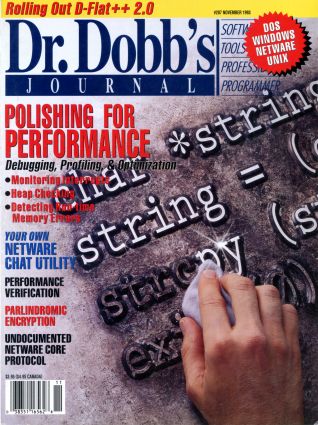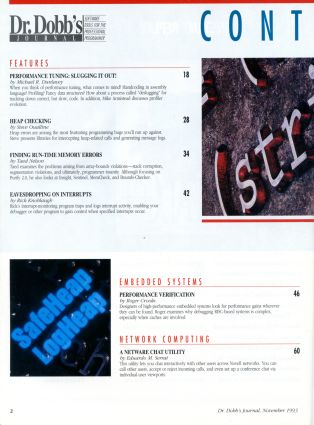
p.6 EDITORIAL
[author : Jonathan Erickson] #Edito
TABLE OF CONTENTS
FEATURES
p.18 PERFORMANCE TUNING: SLUGGING IT OUT!
[author : Michael R. Dunlavey]
When you think of performance tuning, what comes to mind? Handcoding in assembly language? Profiling? Fancy data structures? How about a process called "deslugging" for tracking down correct, but slow, code. In addition, Mike Armistead discusses profiler evolution.
p.28 HEAP CHECKING
[author : Steve Oualline]
Heap errors are among the most frustrating programming bugs you'll run up against. Steve presents libraries for intercepting heap-related calls and generating message logs.
p.34 FINDING RUN-TIME MEMORY ERRORS
[author : Taed Nelson]
Taed examines the problems arising from array-bounds violations—stack corruption, segmentation violations, and ultimately, programmer insanity. Although focusing on Purify 2.0, he also looks at Insight, Sentinel, MemCheck, and Bounds-Checker.
p.42 EAVESDROPPING ON INTERRUPTS
[author : Rick Knoblaugh]
Rick's interrupt-monitoring program traps and logs interrupt activity, enabling your debugger or other program to gain control when specified interrupts occur.
EMBEDDED SYSTEMS
p.46 PERFORMANCE VERIFICATION
[author : Roger Crooks]
Designers of high-performance embedded systems look for performance gains wherever they can be found. Roger examines why debugging RISC-based systems is complex, especially when caches are involved.
NETWORK COMPUTING
p.60 A NETWARE CHAT UTILITY
[author : Eduardo M. Serrat]
This utility lets you chat interactively with other users across Novell networks. You can call other users, accept or reject incoming calls, and even set up a conference chat via individual-user viewports.
EXAMINING ROOM
p.70 EXAMINING OPTLINK FOR WINDOWS
[author : Matt Pietrek]
Optlink for Windows, a high-performance replacement for Microsoft's LINK.EXE and Borland's TLINK.EXE, provides optimizations that increase execution speed while reducing application size.
PROGRAMMER'S WORKBENCH
p.78 DEBUGGING WINDOWS APPLICATIONS
[author : Ray Valdes]
Ray discusses the tools and techniques he uses when figuring out what went wrong with his Windows apps. Ivan Gerencir adds his multi-application message trace facility for Windows.
COLUMNS
p.107 PROGRAMMING PARADIGMS
[author : Michael Swaine]
Michael puts forth this examination of why the Forth language is still a good choice for many applications, and how Forth relates to cellular automata, genetic algorithms, artificial life, and the game of Life.
p.111 C PROGRAMMING
[author : Al Stevens]
Al unchains version 2.0 of is D-Flat++ library—a CUA-compliant library for DOS text mode implemented as a C++ class library. D-Flat++ applications run from a virtual desktop that contains a screen, a keyboard, a mouse, a clock, and a speaker, represented by classes in the library.
p.117 ALGORITHM ALLEY
[author : Tom Swan]
From the year 1661 to today, palindromes are tit-4-tat backwards and forwards. When examining Windows file structures recently, Tom discovered that palindromes are the bases of a data-encryption method.
p.123 UNDOCUMENTED CORNER
[author : Andrew Schulman]
This month, Pawel Szczerbina looks at undocumented aspects of Novell's NetWare Core Protocol (NCP). When examining the so-called "F2 interface," Pawel found hundreds of NCP functions, although Novell only documents the NCP Erase Files function.
p.135 PROGRAMMER'S BOOKSHELF
[author : Peter D. Varhol]
Fuzzy logic is something to think about, and Bart Kosko's new book Fuzzy Thinking is a good place to start mulling it over.
FORUM
p.10 LETTERS
[author : you]
p.152 SWAINE'S FLAMES
[author : Michael Swaine]
PROGRAMMER'S SERVICES
p.146 OF INTEREST

